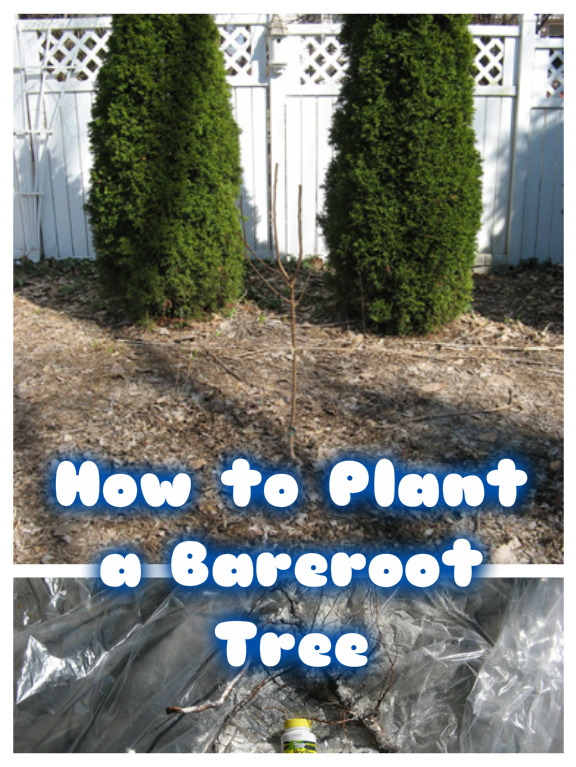How to Plant a Bareroot Tree
You can buy plenty of trees locally, from home centers such as Home Depot or Lowes, or from nurseries or tree farms, most of these will have root balls intact and be potted up. But, if you’re looking for rarer trees, especially specialty varieties of fruit or nut trees, chances are you need to find them through a mail order or online source, and those will almost always be shipped to you bare root. Here is how to plant such trees. For this article I am planting a dwarf variety of apricot. Since I am planting a fruit tree I am going to grow it where it will get good sun, site selection is very important for plants. A Japanese maple will typically want shade, redbuds can usually go either way, but all fruiting trees will want sun, the more the better. Know what your tree needs, and plan ahead as well. An area that may be sunny today, could be shady in 10 years as other trees grow.

Step 1. Examine the tree.
Open your box up and examine your tree, it should look healthy, and alive, with dampness on the roots still. If it is dry and brittle make a note to save your receipts in case it didn’t survive shipping so you can get a replacement from the nursery.

Step 2. Apply a rooting hormone.
You don’t really need to do this, but rooting hormone is fairly cheap and goes a long way, you can treat dozens of trees with one bottle. If the tree’s roots are small enough to fit into a zip log bag, do so and add in some hormone dust and give it a good shake to coat. If not, wrap the roots in some other sort of plastic and do the same thing. Rooting hormone will encourage new roots to form quicker, thus speeding the plant’s recovery from the transplanting process.

Step 3. Dig your hole.
It is said that when planting a tree you should dig a whole twice the width of the root ball and about 80% as deep (to allow for settling. With a bare root plant you do not have a root ball so you need to look at other things.
Your root ball width is the same as the width of your bare roots, so use that as a measurement, but do you really need to dig a bigger hole? No, you don’t. If you are planting in unimproved, untilled, compacted soil, such as in a lawn, yes, dig a wide hole. However, if you’re planting in a raised bed, garden bed, perennial border, or somewhere else that has loose improved soil, there is no need. The reason you dig a wide hole in the lawn is to give the tree’s roots room to stretch out before meeting resistance, in a nice garden bed there is no resistance to meet, so you do not need as wide a hole. Additionally, in a garden bed there may be other plants nearby you want to avoid uprooting.
For plant depth, look at the point where the trunk of the tree turns into roots, usually a few inches below the graft (if it is a grafted tree). This is where you want the soil level to be, additionally, to prevent rot, you want the soil to slow away from the trunk, so dig the hole around 80% the depth of the roots, then mound the soil up over the roots so that the soil slopes away from the trunk.
As you dig your hole put the dirt into an old container or bucket for easy replacing and cleanup afterwards.

Step 4. Backfill.
When your hole is dug place your tree in and add enough dirt back in to hold it steady, now you can think about fertilizing and amending the soil. I added 5 banana peels, banana peels are a great source of potassium for plants, it is free fertilizer, use it. I also added a cup or so of bloodmeal, an organic nitrogen fertilizer. Why use an all natural fertilizer? You’re fertilizing directly on the roots, synthetic fertilizers can burn roots and ultimately kill plants. With organic fertilizers you don’t have to worry about that so you can add more or less as much as you like. I also added a cup or so of bonemeal, an all natural phosphorus fertilizer, for the same reasons as I used the bloodmeal. Those three amendments take care of the tree macronutrients plants need. I also then added a half a cup of mycorrhizal fungus. This is a group of fungi that form beneficial symbiotic relationships with plant roots. Plants grow in soils with high mycorrhizal content can grow twice as vigorously as plants in soil with little or no mycorrhizal.
Soil is probably the single most important factor defining your plant yields (after sunlight) and you only get one chance to condition the soil in the root zone, and that is at planting, so make the most of this opportunity.
When you are done amending the planting hole, backfill with soil and tamp down to ensure good soil-to-root contact.

When finished, water well, and add or replace any mulch (in my case, shredded leaves). This tree may seem small, but within two years it should bear it’s first apricots.
